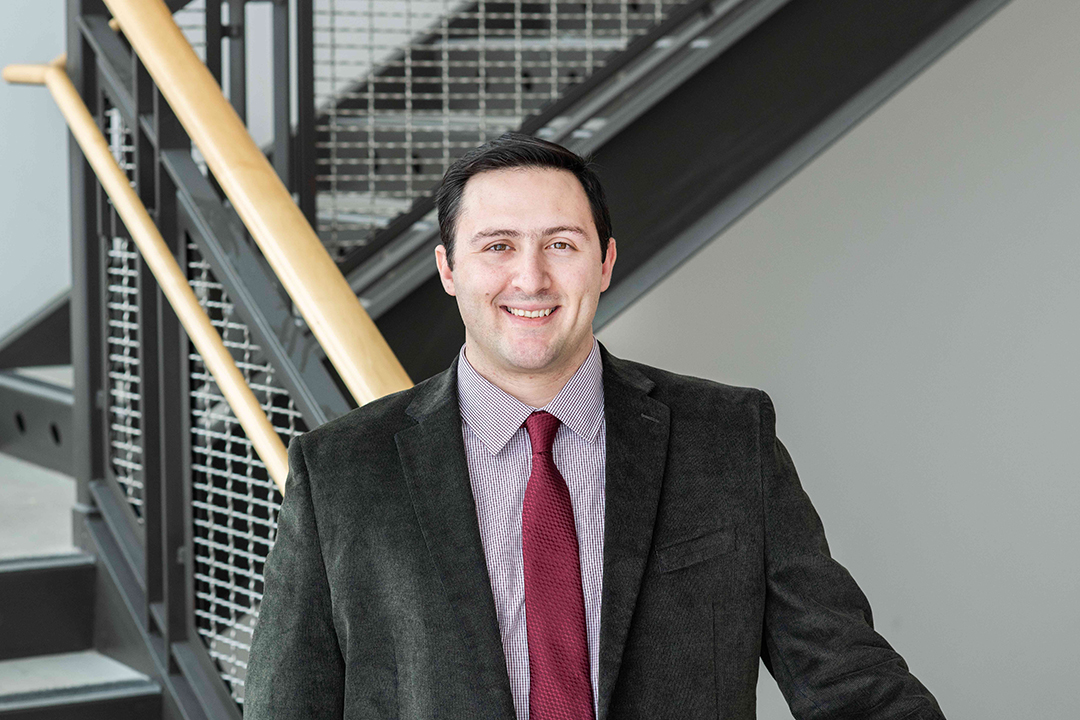Professor wins USAF Research Program Young Investigator Award
Panos Markopoulos will develop theory and optimization methods for more efficient and robust machine-learning capabilities to further defense and cybersecurity
Gabrielle Plucknette-DeVito
Panos Markopoulos recently received an Air Force Research Young Investigator award to develop a more robust sensor analysis system to better evaluate data simultaneously from sources such as cameras, oscilloscopes, and other sensors.
RIT engineering faculty-researcher Panos Markopoulos recently received an Air Force Young Investigator Program award to develop a more robust sensor analysis system to better evaluate data simultaneously from sources such as cameras, oscilloscopes, and other sensors. The research focus is on large volumes of streaming data, collected from diverse sensor platforms, such as multispectral cameras and antenna arrays. The developed theory and technology could enable intelligent machines to learn reliably, even from corrupted data collected from all types of sensors.
“Multi-modal data analysis is one of the most-timely research problems and it is of great interest in the area of machine learning and artificial intelligence. The question is, how can you jointly analyze data that you get from several different sensor deployments or sensing configurations? What is the proper mathematical framework and how can you do this in a robust, dynamic and computationally-efficient way? That is what we are in the process of discovering,” said Markopoulos, assistant professor of electrical engineering in RIT’s Kate Gleason College of Engineering.
Markopoulos is principal investigator for the three-year project “Theory and Efficient Algorithms for Dynamic and Robust L1-Norm Analysis of Tensor Data,” a $348,460 award from the U.S. Air Force Office of Scientific Research (AFOSR), which recognizes projects that can further the military's initiatives in robust computing design, system integration and improved machine-learning capabilities. His research is at the intersection of machine-learning, numerical optimization and data analysis. The new work will deliver groundbreaking methods for processing data from multiple sources. The findings can spur advances in many engineering fields, such as accurate object detection in remote sensing, anti-jamming in wireless communication systems, anomaly detection for cybersecurity, and more efficient neural networks for computer vision.
These foundational technologies can be found in the defense, aerospace and cybersecurity fields, for example, and further refining how computing systems analyze data is essential to these systems being seen as more reliable and robust.
Scientists and engineers collect data from sensor deployment and organize the data as tensors -- multi-dimensional, higher order arrays. Markopoulos generalized what arrays might look like, for example, a two-dimensional tensor can be viewed as a general data table, whereas a three-dimensional tensor would look more cube-shaped. The four-dimensional tensor, though harder to visualize, uses four indices to identify its entries, Markopoulos explained.
Data must be processed and analyzed to infer patterns, to assist in decision-making and to adjust sensors to train AI machines. Processing multi-modal data as higher-order tensor arrays can leverage inter-modality correlations and allow for enhanced inference. For this reason, researchers in the field of signal processing, data mining and machine learning have focused on developing theory and algorithms for tensor processing.
"For example, in remote sensing applications, if you want to detect a vehicle in a hyperspectral image, tensor processing can offer great benefits," he said, adding that Internet of Things technologies enable the use of inexpensive and connected sensing systems. Occasionally sensors malfunction and there might also be interference or corruption in the sensing environment that could have a critical impact in the systems' learning processing and performance.
Algorithms can represent 'learning styles' and computers must recognize data as part of its learning process. It must understand context, relational and classification types of data and environmental information, for example, for solutions or to make predictions. Although computers can analyze data quickly, the challenge today is to intensify that analysis even more efficiently and to assess data from multiple, different sources.
Markopoulos will be conducting will utilize L1 norm-based algorithms that operate on estimated data deviations, instead of data variances.
“At the same time, modern data collections are immense, and often, the cost of machine learning methods becomes prohibitive, especially for edge systems. In many cases, sensing environments and data patterns change dramatically. Learning algorithms have to be able to dynamically adjust to changes,” Markopoulos said. “This is why it is important to focus on computationally-efficient and dynamic methods.”
Complex, high-level mathematics is the learning system underlying artificial intelligence, and Markopoulos will be using these mathematical optimization models to analyze tensor data in a dynamic way. An expert in machine learning and signal processing, he leads the Machine Learning Optimization & Signal Processing Laboratory, the Milos Lab at RIT. The 2020 YIP award will provide Markopoulos with funds to support the research as well as multiple students participating on the project team. Supported by the AFOSR Dynamic Data and Information Processing program, this new work extends a long-time collaboration between the lab and Markopoulos who had been a visiting research faculty member at the U.S. Air Force Research Laboratory in Rome, N.Y. In previous work, his research team has discovered methods to process and classify big data and utilize measurements that improve accuracy in identifying and decreasing data corruption.







